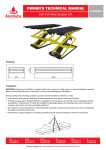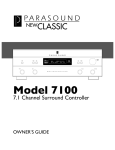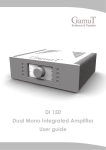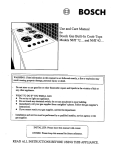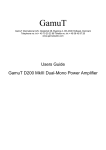Download User Manual - GamuT Audio
Transcript
EXTRAORDINARY SOUND DESIGNS FOR EXTRAORDINARY PEOPLE User Manual Phi3, Phi5 & Phi6 MKII Speakers Phi MKII www.gamutaudio.com Phi MKII User Manual • Phi3, Phi5 & Phi6 MKII Speakers 1 INTRODUCTION The materials and constructions chosen for a GamuT product will make it last a life time and give you years of musical enjoyment. Thank you for choosing a GamuT product. With an optimized production setup we can now offer this exquisite, strong, and inert enclosure solution for music lover to enjoy outstanding performance from real world priced speakers. Having the new improved sonic foundation from the laminated form pressed enclosure; we have done our utmost to optimize other components used, to obtain an absolute maximum of performance. We designed a new woofer and midrange driver based on a wood fiber cone structure, using a size optimized inverted spike dust cap, a low distorting magnet system using aluminum shorting rings, and a dynamic linear suspension. We finished off the performance by hand doping the cones with our proprietary organic leather oil treatment, first used for our El Superiores mid/woofer drivers. Our tweeter is our well known dual ring tweeter, now taken to new heights by an optimized version of the NRLI network. The NRLI network is assuring seem less integration between the woofers, midrange and tweeter, by creating a Non-Resonant perfectly Linked Impulse reproduction. NRLI We also optimized the internal acoustics. The new less resonant character of the enclosure lets us minimize the use of acoustic damping to obtain a higher level of impact and dynamic accuracy, as well as improving the quality and level of bass reproduction. The Combination of all of the advantages from the new enclosure, the new higher performing bass/mid drivers, the optimized NRLI network and the new impulse accurate internal acoustics, lifts the performance of the new Phi’s way above what can be expected in this size and price range, and gives the Phi’s a performance level belonging to the top of audiophile musical speakers. 2 Phi MKII User Manual • Phi3, Phi5 & Phi6 MKII Speakers SETTING UP A speaker is an acoustic instrument; it will work with your room and generate a combined character. To minimize the negative influence from the room and optimize the linearity of the combined reproduction please follow the simple guide lines below. To fine trim the performance, go to the advanced setup section. Distances are measured from the Tweeter. Minimum recommendations in a regular setup Distance to side walls: 4’ or 1,2m Distance to the rear wall: 3’ 4” or 1,0m With the “Narrow room” setup (excessive toe-in where axis meet in front of the listening position) Distance to side walls: 2’ 4” Distance to the rear wall: 4’or 1,2m With both the regular setup and the Narrow room setup, position you speaker a minimum of 10’ or 3m apart and the listening position a minimum of 10’ or 3m from the speaker. With a regular setup point the speaker straight forward With the Narrow room setup (where the 3’ clearance to the side room cannot be achieved, requires a 16’ wall distance) toe-in the speakers so that the axis of the tweeter is crossing app. 2’-3’ or 60-90 cm in front of the listening position Adjust the spikes so that a line starting from the top point of the Midrange (the driver below the tweeter), and running in parallel with the top of the speaker, is pointing to your ear height in the listening position. If trimming of the bass, midrange or tweeter level is needed; you can adjust the Bass balance by changing the position of the speaker, the midrange character by adjusting the tilt of the speaker, and the tweeter level by adjusting the toe-in. Visit the advanced setup section for instructions or e-mail us at: [email protected] CONNECTIONS Spike adjustment: The new Spike system is designed to penetrate heavy carpeting, by using a sharply shaped center Spike. The Spike is locked by the outer Knob. Loosen the knob counter clockwise to allow adjustment of the Spike. Use an Allen key (Unbrako), size 6 mm, to adjust the spike. Adjust the spikes to have an even weight distribution (same slight resistance when turning the key) to eliminate movement of the speaker. When the Speaker is positioned in its desired position turn the outer Knobs Clockwise by hand, until they lock, to lock the spikes. The newly designed proprietary GamuT Terminals are made to allow the use of 3 different connections: 8mm spades, 4 mm banana plugs or stripped wire. Connect your speaker cable to the speaker before connecting to the amplifier. When using Banana plugs insert the plugs in the center hole, make sure the fit is as tight as possible. When using a Spade, loosen the desired terminal nut and insert the spade between the terminal and the bracket. When using a stripped wire remove the terminal nut and insert the stripped wire into it. Position the stripped wire onto the conical part of the terminal base and re-position the terminal nut onto the thread and turn the nut until it locks the wire. Phi MKII User Manual • Phi3, Phi5 & Phi6 MKII Speakers 3 OPTIMIZING THE SOUND 1. RUNNING IN (BREAKING IN) Speakers are electro mechanical devices. As any mechanical device a speaker needs running in before it reaches its optimum performance level. During the development phase we have carefully aligned and trimmed all components to have a perfect balance when fully run in, so please allow for the speaker to have a run in period of up to 200 Hours of music playing and an ageing of minimum 6 months before they reach their 1. Running in (breaking in): optimum performance. During the run in period the final positioning of the Running in (breaking in): Speakers are character electro will speaker cannot be determined as the bass mechanical devices. As any mechanical device change. Please also allow time for the mid and tweeter acharacter speakertoneeds running in before it reaches its fall into place. optimum performance level. During the development phase we have carefully aligned and trimmed all components to have a perfect balance when fully run in, so please allow for the speaker to have a run in period of up to 200 Hours of music playing and an ageing of minimum 6 months before they reach their optimum performance. During the run in period the final positioning of the speaker cannot be determined as the bass character will change. Please also allow time for the mid and tweeter character to fall into place. Optimizing the sound 2. ADVANCED SETUP Positioning; Optimizing the Bass character & balance: Please go to the “Setting Up” section to find the minimum distances to walls etc. and choose your way of setting up: “Regular” or “The Narrow Room” setup A room has standing modes of energy. The most harmful modes are positioned in multiplications of 1/2Advanced fractions ofsetup: the room dimensions, I.e. the position 2. where the room length, width and height is divided • the Bass withPositioning; 2, 4, 8, 16 etc. Optimizing The obvious solution is tocharavoid acter & balance: Please go to the these positions by positioning the speaker in“Setting un-even Up” section to find the minimum distances to fractions of the room dimensions. walls etc. and choose your way of setting up: or The “Regular” preferred divisions of room dimensions are: Narrow Room” setupbelow. 1/3,“The 2/7, 1/5 & 1/7 see the diagram • A room has standing modes of energy. The most harmful modes are positioned in multiplications of 1/2 fractions of the room dimensions, I.e. the position where the room length, width and height is divided with 2, 4, 8, 16 etc. The obvious solution is to avoid these positions by positioning the speaker in uneven fractions of the room dimensions. • The preferred divisions of room dimensions are: 1/3, 2/7, 1/5 & 1/7 see the diagram below. Example Measurements Results Divided by 7 Divided by 5 2× divided by 7 Divided by 3 2× divided by 5 3× divided by 7 Example width 5 meters 0,72 1,0 1,44 1,67 2,0 2,16 Example length 7meters 1,0 1,4 2,0 2,33 2,8 3,0 Divided by 5 2× divided by 7 Divided by 3 2× divided by 5 3× divided by 7 Your measurements Measurements Results Divided by 7 Your measured width – write here Your measured length – write here 4 Phi MKII User Manual • Phi3, Phi5 & Phi6 MKII Speakers • TheThe process to calculate is your to draw process to calculate is to draw roomyour with room with measured dimensions and draw measured dimensions and draw lines with the specified lines with thedimensions specified both divisions thewidth dimen divisions of the lengthofand wise. sionsthe both lengththat andexceed width the wise. Choose the Choose positions minimum req uirepositions that exceed the minimum ments for clearance to the walls and allowsrequirethe miniments for clearance tospeakers. the walls and allows mum spacing between the the minimum spacing between the speakers. Speaker Width /7 Width /5 2 × Width /7 Length /7 2 × Length /7 You have 6 possible listening positions Length /5 Length /3 Where each of the measured lines cross, you have a possible speaker position. Length /5 2 × Length /5 Length /7 2 × Length /7 3 × Length /7 • Tilting: Tilting; Optimizing the midrange Optimizing the midrange charactercharacter: Use thefrom guidelines from Up” the section “Settingto Use the guidelines the “Setting Up”the section the Adjustments tilt of the speakers. adjust tilt of to theadjust speakers. of the tilt ofhave the tilt the speaker will have of Adjustments the speaker will theof following sonic effect: the following sonic effect: By tilting the speaker towards the front, i.e. leaning more the speaker midrange character more By forward, tilting the towardswill thebefront, aggressive or “forward”. i.e. leaning more forward, the midrange char- acter will be more aggressive or “forward”. By tilting the speaker towards the back, i.e. leaning more speakertowards will be lessthe aggressive By backwards, tilting thethe speaker back, or i.e. “laidleaning back”. Fine trim the speaker tilt to optimize more backwards, the speaker will thebe midrange character.or “laid back”. Fine trim the less aggressive speaker tilt to optimize the midrange character. Phi MKII User Manual ® • Phi3, Phi5 & Phi6 MKII Speakers 5 OPTIMIZING THE SOUND Toe-in: Optimizing the tweeter character: You have chosen to setup using the “Regular” or the “Narrow Room” setup. By adjusting the toe-in the tweeter level and character can be optimized Toe-in: Optimizing the tweeter character • You have chosen to setup using the “Regular” or Room”acoustic setup. By environment adjusting the toe-in • the In “Narrow a “perfect” our the tweeter level and character canlistened be optimized. speakers are designed to be to app 20-25 degrees off axis, which corresponds Intoa “perfect” environment our speakers a normal acoustic setup with the speakers close toare designed to be listened to app 20-25 degrees off axis, pointing straight. By using toe-in the tweeter which corresponds to a normal setup with the speakers will point more towards the listening position close to pointing straight. By using toe-in the tweeter thereby increasing its level, as the highest level will point towards the listening position from themore tweeter is obtained directly on thereby axis. Please note that the increase/decrease in toe when using this solution is more critical compared to using the Regular setup, only a few degrees change of Toe will cause a great in the subjective tweeter level. Pleasechange note that increase/decrease in toe when using this solution is more critical compared to using the wRegular setup, only a few degrees change of Toe will cause a great change in subjective tweeter level. increasing its level, as the highest level from the tweeter is obtained directly on axis. In the Regular Setup, with the tweeter axis pointing close to straight, use toe-in to In the Regular Setup, with the tweeter axis pointing increase the tweeter levels, and use toe-out to close to straight, use toe-in to increase the tweeter decrease the tweeter levels • levels, and use toe-out to decrease the tweeter levels • InInthe the Narrow Room The tweeter Narrow Room Setup,Setup, The tweeter axis is axis is toed-in to meet in front of listening toed-in to meet in front of the listeningthe position. position. To increase the tweeter levels toe-out To increase the tweeter levels toe-out the speakers, the speakers, and to decrease the tweeter and to decrease the tweeter levels toe-in the speakers. levels toe-in the speakers. The Narrow Room Width /7 Length /5 The optimized low frequency speaker location More high frequency; less toe-in / pointing more directly to the ear Less high frequency; more toe-in Width /7 6 6 Phi MKII User Manual • Phi3, Phi5 & Phi6 MKII Speakers M inenT User manual – M3, M5 & M7 Speakers ® The optimized listening position CARE & MAINTENANCE MAINTAINING THE PERFORMANCE Over time a mechanical connection will loosen slightly, and will deteriorate due to atmospheric influence. To keep the optimum performance, clean and tighten the connections on a regular basis. A clean cloth slightly soaked in spirit is recommended to clean the gold plated connections and cables. MAINTAINING THE SURFACES Clean the lacquered and fabric covered surfaces using a clean damp cloth, or a soft brush, soaked in a light detergent solution. CLEANING THE DRIVERS When cleaning the speaker drivers, be sure not to apply excessive pressure, these are delicate items and bending or deforming the diaphragms will deteriorate the sonic performance, a soft brush without detergent is recommended. Phi MKII User Manual • Phi3, Phi5 & Phi6 MKII Speakers 7 EX TECHNICAL DATA PHI5 FLOOR PHI6 LCR Construction 2 Way Impulse Optimized Bass Reflex 3 Way Added Bass Impulse Optimized Bass Reflex 2 Way Impulse Optimized Bass Reflex Bass / Mid Drivers 1 x 150mm Dynamic linear Mid-Woofer 1 x 150mm Mid-Woofer & 2x 150mm Woofer 2 x 150mm Dynamic linear Mid-Woofer High Freq. Driver 25 mm Dual concentric ringradiato 25 mm Dual concentric ringradiato 25 mm Dual concentric ringradiato Frequency Response 58 - 40000 42 – 40000 Hz 58 – 40000 Hz Impedance 4 Ohms nominal minimum 4 Ohms at 220 Hz 4 Ohms nominal minimum 3,2 Ohms at 200 Hz 4 Ohms nominal minimum 3,1 Ohms at 240 Hz Sensitivity for 2.8V Input 86,5 dB 88,5 dB 86,5 dB Crossover Points 2100 Hz 530 Hz & 2150 Hz 260 Hz & 2100 Hz Size (WxHxD) mm/inch 170*330*240/ 67”*130”*95” 170*1050*270/ 67”*414”*166” 510*170*240/ 201”*67”*95” Weight 6 Kg / 13 Lbs 17 Kg / 37 Lbs 9 Kg / 20 Lbs ©GamuT Audio, All rights reserved PHI3 MONITOR • GamuT Audio, Siggardsvej 2 – DK 6818 Aarre Denmark P M









